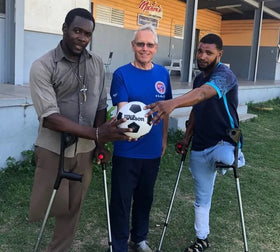Miki Fairley, O&P Edge interviews Thomas Fetterman about crutch innovation
Although ambulating with crutches would probably not rank on anyone's A-list of favorite activities, it can solve the problem of mobility after injury. Crutches have a long history. Evidence from an Egyptian carving dating back to 2830 BC suggests that crutches have been used at least since the pharaohs ruled Egypt 5,000 years ago. Through the corridors of time crutch design has not greatly changed. However, some modern inventor's have set out to change that scenario developing innovative twists on this age-old solution.
Like many innovations in the rehabilitation field, several new crutch designs have been sparked by their inventors necessity and dissatisfaction with what was already out there, while others have been inspired by a fascination with high-tech materials.
'Vertical into the Future'
At age eight, Thomas Fetterman fell victim to the polio epidemic that swept the country in the 1950s. He developed inflamed shoulder joints in the 1980s due to the impact of constant crutch use. "My doctor just told me to slow down and take aspirin," he recalls.
Two negative aspects to using crutches, according to Fetterman, are slipping and falling on slick or uneven surfaces, and the harmful effects of long-term crutch use on cartilage, bone, tendons, and nerves. "The single most important aspect of any crutch or cane is the way it engages the ground. If you don't get that part right, the crutch or cane wont be of much value."
Fetterman knew what was needed: greater ground-grabbing ability plus shock absorption. He developed and patented a crutch tip with a shock-absorbing gel system, and in 1988 began manufacturing and selling the tips. Today, Thomas Fetterman Inc., Southampton, Pennsylvania, provides a variety of crutches, canes, tips, and crutch accessories.
The Smithsonian Institute chose Fetterman's Litestix titanium forearm crutch as part of its exhibit, "History of Polio," to show the technical advances in crutch design and materials.
Fetterman crutches are custom-made to fit a customer's exact needs. Since they are custom-made, there are no adjustment holes to start to wear, "egg out," and start clicking and clattering, he notes.
While Fetterman uses the forearm crutch, which is the preferred design in Europe and much of the rest of the world, axillary (underarm) crutches have been more commonly used in the United States. "Various studies plus my own experience shows that the forearm crutch is less deleterious to the body and a better solution for long-term crutch users. Its convenient in other ways as well—its shorter and fits in the overhead bin of an airplane. And you can store them under the table in a restaurant without tripping too many waiters," he adds with a chuckle.

